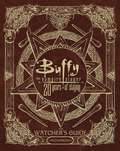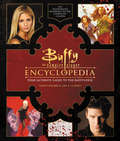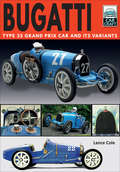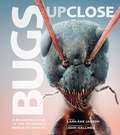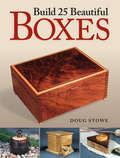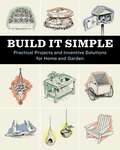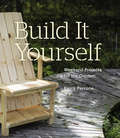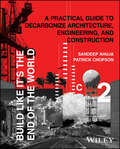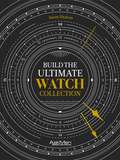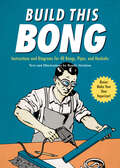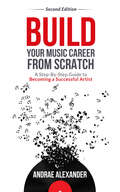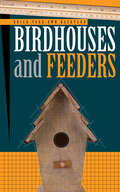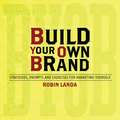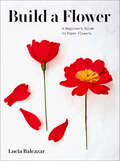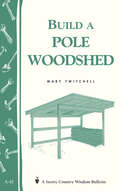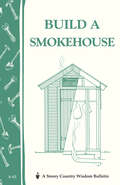- Table View
- List View
Buffy the Vampire Slayer 20 Years of Slaying: The Watcher's Guide Authorized
by Christopher GoldenA special hardcover collector’s edition of the authorized Buffy the Vampire Slayer Watcher’s Guides, now with updated content from the cast and crew!As long as there have been vampires, there has been the Slayer. One girl in all the world to find them where they gather and to stop the spread of their evil and the swell of their numbers. From the first vampire staking to the last glimpse of Sunnydale, Buffy the Vampire Slayer was a genre-busting hit, attracting millions of fans worldwide. Even now, two decades later, Buffy the Vampire Slayer still plays a role in shaping an entire generation of media. Just in time for the show’s twentieth anniversary, the Buffy the Vampire Slayer Watcher’s Guides have been compiled into one hardcover collector’s edition for the first time! Inside, you’ll find all the best content from Volumes 1–3 of the original Watcher’s Guides, as well as exclusive new content, including never-before-seen interviews with the cast and crew.
Buffy the Vampire Slayer Encyclopedia: The Ultimate Guide to the Buffyverse
by Nancy Holder Lisa ClancyA comprehensive, authorized compendium of all things Buffy the Vampire Slayer, published in celebration of the revered show’s twentieth anniversary.From its debut in 1997, Buffy the Vampire Slayer became a cult hit with legions of devoted viewers and propelled the show’s creator Joss Whedon to stardom. Now, fans can discover Buffy’s world fully with this full-color A-to-Z encyclopedia that catalogs, explains, and cross-reference every detail of the Buffyverse, from characters, locations, and weapons to episodes, demons, and recurring gags. Packed with content from the television show, The Buffy the Vampire Slayer Encyclopedia is the first companion book that also includes key facts from the official canon comics and its spin-off show Angel—making this comprehensive volume the only truly complete guide to the entire Buffyverse.Lavishly produced and written by Buffy experts, The Buffy the Vampire Slayer Encyclopedia is the authoritative source for fans, allowing them to indulge in the intricacies and nuances of the series as never before. With color stills and photography throughout, an eerie cover with special effects, and an incredible design that reflects the show’s aesthetics, this fully authorized companion is a must-have for all Buffy enthusiasts.Buffy the Vampire Slayer TM & © 2017 Twentieth Century Fox Film Corporation. All rights reserved.
Buffy the Vampire Slayer: Ditch the Demons and Be Your Own Hero
by Micol OstowAre you ready to be strong? Inspired by the badass ladies of Buffy the Vampire Slayer, this is the ultimate guide for living your most killer life.Buffy turned tired, sexist tropes on their head when it debuted in the '90s and introduced a truly empowered heroine (and a kickass roster of female supporting roles). So who better than Buffy and her fellow babes -- Willow, Cordelia, Faith, Anya, Tara, and others -- to teach us how to slay our own personal demons? The ladies have much to offer in terms of savvy insights, observations, and life lessons.Slay Like a Girl examines the groundbreaking female paradigms presented in Buffy and offers digestible, entertaining lessons for slaying at work, in love, and beyond. Also featuring photos from the show, memorable quotes, and fresh input from modern ladies who slay, Slay Like a Girl is an indispensable handbook for fans, feminists, and all other fierce folk.
Bug Out Vehicles and Shelters: Build and Outfit Your Life-Saving Escape
by Scott B. WilliamsA CATACLYSMIC DISASTER STRIKES YOUR AREA.How will you evacuate your family to safety?Do you have a vehicle you can count on?Can it double as a mobile retreat, or do youhave a shelter prepared in advance?What's your plan for reaching the shelter?Bug Out Vehicles and Shelters gives you the vital answers and options for becoming a survivor instead of a refugee:VEHICLES Prepping fast-escape vehicles Using specially equipped vehicles for unique situations Planning for backup vehicles if your main escape option fails Utilizing bikes, canoes, kayaks, rowboats and other human-powered means of escapeSHELTERS Preparing temporary shelters Locating and stocking longterm shelters Using an RV, motorhome, camper trailer or converted utility vehicle Living aboard boats, from motorboats to houseboats to blue-water sailboatsExplaining the advantages and drawbacks of each vehicle and shelter option, this survival handbook zeroes in on the key considerations and essential equipment for planning all your bug-out needs.
Bugatti: Type 35 Grand Prix Car and Its Variants (Car Craft)
by Lance ColeThis expert volume examines the engineering, design, and modeling of this classic sportscar through the years—fully illustrated with color photos. Innovative car designer Ettore Bugatti changed the history of both motorsports and engineering with the legendary T35. Introduced at the Grand Prix of Lyon in 1924, its clever engine design, new suspension thinking, and distinct body style marked the beginning of a new era in car racing. Automotive journalist, industrial designer and Bugatti expert Lance Cole pays tribute to this iconic automobile in a detailed yet engaging commentary. Fully illustrated with color photos, this volume chronicles the story of the T35&’s design and evolution. For the car modeling enthusiast, Cole also details the modeling options in synthetic materials and die cast metals.
Bugatti: Type 35 Grand Prix Car and Its Variants (Car Craft)
by Lance ColeThis expert volume examines the engineering, design, and modeling of this classic sportscar through the years—fully illustrated with color photos. Innovative car designer Ettore Bugatti changed the history of both motorsports and engineering with the legendary T35. Introduced at the Grand Prix of Lyon in 1924, its clever engine design, new suspension thinking, and distinct body style marked the beginning of a new era in car racing. Automotive journalist, industrial designer and Bugatti expert Lance Cole pays tribute to this iconic automobile in a detailed yet engaging commentary. Fully illustrated with color photos, this volume chronicles the story of the T35&’s design and evolution. For the car modeling enthusiast, Cole also details the modeling options in synthetic materials and die cast metals.
Bugs Up Close: A Magnified Look at the Incredible World of Insects
by Lars-Åke Janzon John HallménBugs are usually so small that we hardly notice them, let alone think of them as living beings. But call upon the magnifying glass, and a shapeless jumble of legs, wings, and antennae suddenly start staring back at us.About 80 percent of the Earth's animals are insects. While there are millions of different species, we rarely see many of them . . . until now. Thanks to the photography of John Hallmén, who took a camera and magnified these magnificent creatures one hundred times, we can see what we've never been able to see before.Bugs Up Close takes readers on a journey into a world rarely seen, with incredible photographs of such insects as:Crane fliesYellow meadow antsBlack fungus beetlesTreehoppersAnd many more!The diversity of this insect civilization is striking and unknown to most. An insect we may never have thought twice about now looks like a creature from outer space. Fascinating and somewhat monstrous details such as compound eyes, antennae, and sharp mouth parts are visible, and with text by Lars-Åke Janzon, Bugs Up Close is an amazing close look into the strange and beautiful world of insects.
Build 25 Beautiful Boxes
by Doug StoweThink inside the box! Looking for a fun way to make use of those offcuts you've been saving? Making wooden boxes is a great way to use scrap lumber or exotic woods that can prove too expensive for larger projects. Boxes require a minimal amount of material but afford you the opportunity to learn and practice a range of woodworking techniques. Plus, handmade boxes make great gifts.Build 25 Beautiful Boxes features an array of gorgeous boxes for a variety of special uses. You'll find stunning designs for jewelry boxes and chests, boxes for pens, a wedding ring music box, boxes with unique shapes and distinctive gift boxes. Along the way you'll learn inlay and joinery techniques that can be applied to other areas of your woodworking. Inside you'll find:25 art and heirloom box projects designed by a box-making masterStep-by-step instructions for making inlay and using it to enhance your projectsGreat ideas for using precious wood scrapsHelpful tips for sourcing woodLet this book be your guide and start making your own beautiful wooden boxes today.
Build It Simple: Practical Projects and Inventive Solutions for Home and Garden
by How-To Experts at Storey PublishingDiscover 50 simple, thrifty, low-tech projects that you can create, even if you're a novice builder! With simple tools and materials and just basic building skills, you can make exactly what you need for all of your backyard and gardening projects, from a tool shed and storage bins to lawn chairs, fences, plant supports, and feeders for your chickens. These sustainable, timeless designs, paired with step-by-step instructions and resourceful tips provide a wealth of ideas for a practical and purposeful garden and home. This publication conforms to the EPUB Accessibility specification at WCAG 2.0 Level AA.
Build It Yourself: Weekend Projects for the Garden
by Frank PerroneAre you into gardening, DIY, or organic living? Looking to branch into woodworking? Build It Yourself: Weekend Projects for the Garden will help you to do just that. Accompanying you every step of the way, from the local home goods store to your workshop or table, Build It Yourself is a fun, accessible, and portable guide to constructing twelve practical, tasteful projects for your garden and home.Author and master woodworker Frank Perrone instructs with the novice in mind. Each project is designed for simple building, complete with a materials list, a cut sheet that makes getting lumber a snap, dimensional diagrams, illustrated step-by-step instructions with attention to every detail, and "Helpful Hints," plus space for notes.
Build It with Dad: Woodworking Fun for the Whole Family
by A. J. HamlerBuild some family fun--in the woodshop! What could be better than spending some quality time with your kids? How about spending time with them in the woodshop? Perfect for any woodworker with kids, Build It with Dad features 22 woodworking projects that kids of all ages will love. These easy-to-make projects will help you teach your kids how to correctly and safely use fundamental tools such as handsaws, hammers, screwdrivers, tape measures, and cordless drills. Best of all, they'll have fun doing it! Projects include: Fun fantasy sword Working trebuchet Bird feeder Tabletop foosball game Display shelf for collectibles Candy dispenser And many other toys, games and gadgets! Woodworking is a great way to teach kids about using tools, instill a good work ethic, build self-confidence, and simply spend time together as a family. Complete with measured drawings and step-by-step color photos, the projects in this book will give kids creative skills and family memories they'll value the rest of their lives.
Build Like It's the End of the World: A Practical Guide to Decarbonize Architecture, Engineering, and Construction
by Sandeep Ahuja Patrick ChopsonAuthoritative roadmap to the design and construction of a carbon-positive built environment Build Like It’s the End of the World stands as a compelling manifesto for the AEC industry, confronting the urgent challenges of climate change with actionable solutions. Authored by Sandeep Ahuja and Patrick Chopson, this text embarks on a journey to redefine the future of our built environment. Through a lens of decarbonization, it challenges established norms and introduces a new benchmark for sustainable design and construction. This book not only advocates for a radical shift in design and construction philosophy but also provides a concrete blueprint for achieving carbon-positivity in our projects and practices. The authors bring their extensive experience and research to the forefront, offering a guide that marries rigorous analytical methods with practical applications. It is a call to action, urging professionals and students alike to embrace innovative technologies and strategies that can lead to significant changes in how we conceive and construct our spaces. Within its pages, readers will find: A comprehensive strategy for carbon-positive design: a detailed blueprint showcases step-by-step how sustainable practices can be integrated into projects, drawing on the authors’ vast experience and thorough research. Engaging tools for practical implementation: bridging the gap between high-level sustainability goals and their execution, providing readers with learning objectives, instructional activities, and compelling case studies.Insights on embedding sustainable practices: it offers valuable perspectives on incorporating carbon-positive principles into existing workflows, highlighting the simplicity and profound impact of these efforts.The economic and cultural case for sustainable buildings: demonstrating the viability and necessity of carbon-positive buildings, emphasizing the importance of a cultural shift towards decarbonization in the construction industry. Build Like It’s the End of the World is an essential read for anyone in the AEC field looking to navigate the complexities of decarbonization of buildings. It serves as a powerful testament to the role of technology and strategic innovation in transforming the industry, guiding us towards a future where our buildings play a pivotal role in the health of our planet.
Build Stunning Real-time VFX with Unreal Engine 5: Start your journey into Unreal particle systems to create realistic visual effects using Niagara
by Hrishikesh AndurlekarCreate professional real-time particle systems and particle asset creation workflows for games with the power of Niagara and Unreal Engine 5Key FeaturesExplore how Niagara can make your games pop by creating stunning particle systems in Unreal Engine 5Level up your VFX skills and enhance your employability in a competitive marketBuild various particle system projects to reinforce your learning and put your new knowledge into practiceBook DescriptionWhile no game would be complete without visual effects, the ever-evolving VFX industry churns out stellar digital environments that can make your games stand out from the crowd. Build Stunning Real-time VFX with Unreal Engine 5 is here to help you boost your creativity using Niagara to make jaw-dropping particle systems backed by the power of Unreal Engine 5—without a line of code. This handy guide for VFX artists takes you through the principles and concepts of designing particle systems and design workflows, along with the architecture of Niagara, Unreal Engine 5's VFX system. Throughout the book, you'll build a series of mini projects that will put your particle system knowledge to the test. As you advance, you'll cover topics such as creating your own custom modules, debugging workflows, and controlling particles with blueprints, and conclude by working on two projects that will bring everything together into a neat package. By the end of this VFX book, you'll have a deeper understanding of particle systems, improving your skills, portfolio, and the chances of being employed by studios using Unreal Engine 5.What you will learnBrush up your vector mathematics skillsAccess and create namespaces in NiagaraAdd a Niagara system to a Blueprint actorCreate a particle system with dynamic inputsPublish a custom module for your team members to useCreate Niagara Scratch modulesEnable your particle emitters to communicate using event handlersControl Niagara systems using Blueprint public variablesWho this book is forThis book is for visual effects artists transitioning to real-time virtual production workflow as well as beginners looking to learn Niagara for games and other real-time applications. Game programmers, 3D generalists, and game designers interested in adding VFX for their game and metaverse projects will also find this book useful. A basic understanding of Unreal Engine 5, blueprints, as well as layout, materials, and lighting in Unreal Engine is expected.
Build The Ultimate Watch Collection
by Jason HeatonIf you've been bitten by the watch-collecting bug, Jason Heaton's book is here to help you identify what you're looking for and strategize your collection. In seven chapters, Heaton introduces the key watch categories and reveals the most perfect example of each type. Your watch collection begins here.
Build This Bong: Instructions and Diagrams for 40 Bongs, Pipes, and Hookahs
by Randy StrattonConstruct your own smoking devices—from simple to elaborate—with easily obtained materials. Includes bonus instructions for making your own vaporizer! The first book ever to feature detailed directions for bongs, pipes, hookahs, and more, Build This Bong brings both the classics and entirely original showstoppers to the home workshop. Projects of all sorts—from a standard gravity bong to a rubber ducky hookah and a state-of-the art vaporizer—come to life with Popular Mechanics-inspired illustrations and simple instructions. No fancy materials necessary: handyman Randy Stratton shows how to construct everything from common household goods. Build This Bong’s forty inventive projects—made from melons, coconuts, snow-globes, teapots, and more—are sure to be a big, mind-blowing hit.
Build Your Music Career From Scratch
by Lisa D. Kastner Andrae AlexanderA Step-By-Step Guide to Becoming a Successful Artist with tactical and strategic guidance. A how-to with personal anecdotes and experiences to reinforce the techniques and guidance.
Build Your Own Backyard: Birdhouses and Feeders
by Ken BeckDiscover the fun and excitement of backyard birding with this great family activity! Filled with easy-to-follow detailed plans, Build Your Own Backyard Birdhouses and Feeders is a must-have for woodworkers, birding enthusiasts, and hobbyists. Build Your Own Backyard Birdhouses and Feeders features plans in a variety of styles, from very simple to a bit more challenging; full-color, detailed illustrations and step-by-step instructions to guide every step; and a complete materials list that notes everything needed to complete the project. You can always buy a birdhouse or feeder, but making one with your own hands is sure to increase your enjoyment of this fascinating backyard hobby.
Build Your Own Brand
by Robin LandaWhat is your brand? As a designer your success depends on how you brand yourself and the service you provide. This book will help you explore, develop, distill, and determine a distinctive brand essence, differentiate yourself, and create your visual identity. Build Your Own Brand is a guided journal designed to help you sketch, write, design, and conceive the way you brand yourself. More than 80 prompts and exercises will help you develop your: Personal brand essence Visual identity and style Resume and elevator pitch and much more! Whether you're trying to land a new job or launch a design business, let this unique guide light the way. You'll find helpful advice, interviews, and prompts from esteemed psychologists, creative directors, brand strategists, designers, artists, and experts from a variety of disciplines. Build your own brand today!
Build Your Own Brand: Strategies, Prompts and Exercises for Marketing Yourself
by Robin LandaWhat is your brand?As a designer your success depends on how you brand yourself and the service you provide. This book will help you explore, develop, distill, and determine a distinctive brand essence, differentiate yourself, and create your visual identity.Build Your Own Brand is a guided journal designed to help you sketch, write, design, and conceive the way you brand yourself. More than 80 prompts and exercises will help you develop your:Personal brand essenceVisual identity and styleResume and elevator pitchand much more! Whether you're trying to land a new job or launch a design business, let this unique guide light the way. You'll find helpful advice, interviews, and prompts from esteemed psychologists, creative directors, brand strategists, designers, artists, and experts from a variety of disciplines. Build your own brand today!
Build Your Own Home Office Furniture
by Danny ProulxBuild your own home office furniture!You want the best for your home office, from practical workstations to stylish bookcases. Danny Proulx shows you how to transform any room into the perfect workspace, offering invaluable tips and advice, plus 13 fresh, functional, fun-to-build projects packed with detailed photographs and step-by-step instructions.Designs range from simple storage modules to a computer desk/workstation, so whatever your level of skill, you'll find plenty of woodshop excitement. It's the kind of furniture that makes the office of your dreams...a reality.Projects include: • File and Storage Drawer Module • Lateral File Cabinet • Basic Workstation • Executive Work Center • Credenza and Bookcase Hutch • Armoire Work Center • Office Bookcase • Desktop Organizer • Media Storage Center • Closet Work Center • Stand-Up Desk • Writing Desk • Laminate Tabletop Construction
Build Your Own Inexpensive Dollhouse
by E. J. TangermanAnyone, even a novice woodworker or a child with adult supervision, can build this spacious dollhouse. All it takes is six basic tools (a folding rule, square, saber saw, rasp, sander, and hammer) and a single sheet of 4' x 8' plywood. The finished two-story model measures 36 1/2" x 26" (scale 1" x 1') and boasts six rooms, plus a staircase, windows, shutters, and a front door.The easy-to-follow instructions offer advice on purchasing the appropriate kind of plywood and trimmings and explain exactly how to cut and assemble the pieces. Helpful tips include suggestions on sanding, which pieces to nail first, constructing the roof, and finishing the project with paint or siding.The basic house design is simple, so builders have ample room to refine the house to suit their own preferences. Dozens of diagrams and instructions show how to add optical touches such as dormers, windowpanes, a fireplace, flower boxes, and much more. All instructions are clarified by illustrations -- over 40 diagrams and photographs appear throughout the book, showing the dollhouse in various stages of completion.
Build a Classic Timber-Framed House: Planning & Design/Traditional Materials/Affordable Methods
by Jack A. SobonBuild a classic, enduring, and affordable home. With Jack A. Sobon’s careful guidance, you can construct your own timber-framed house in the traditional hall-and-parlor style. From felling trees to cutting timbers, and frame construction to door selection, you’ll find Sobon’s professional advice and hand-drawn illustrations invaluable. Whether you’re a first-time builder or a seasoned contractor looking to expand your repertoire, you’ll find answers to all your timber-frame questions. Open the front door and walk into the home of your dreams.
Build a Flower: A Beginner's Guide to Paper Flowers
by Lucia BalcazarLearn to create beautiful, long-lasting paper flowers in a matter of minutes for gifts, decorations, and more, with this step-by-step guide. Paper flowers are ideal for any crafter: The results are stunning but the steps to get there are achievable at any skill level. Build a Flower will teach the basic techniques needed for crafting paper flowers, building upon skills as it moves through a select number of flowers and focusing on key tips: what type of paper works best, petal shapes that work for multiple flowers, how to assemble, and more. With photographs and step-by-step instructions as their guide, readers will learn to build five flowers, variation ideas for their coloring, and final arrangements. And the designs and ideas will inspire crafters to think beyond the vase—paper flowers as gifts, as decorations, and more. This beginner book will open the door to a wide variety of possibilities and will help establish a new audience well versed in the craft, returning time and again to this book’s pages for inspiration and encouragement.
Build a Pole Woodshed: Storey Country Wisdom Bulletin A-42 (Storey Country Wisdom Bulletin Ser.)
by Mary TwitchellSince 1973, Storey's Country Wisdom Bulletins have offered practical, hands-on instructions designed to help readers master dozens of country living skills quickly and easily. There are now more than 170 titles in this series, and their remarkable popularity reflects the common desire of country and city dwellers alike to cultivate personal independence in everyday life.
Build a Smokehouse: Storey Country Wisdom Bulletin A-81 (Storey Country Wisdom Bulletin Ser.)
by Ed EpsteinSince 1973, Storey's Country Wisdom Bulletins have offered practical, hands-on instructions designed to help readers master dozens of country living skills quickly and easily. There are now more than 170 titles in this series, and their remarkable popularity reflects the common desire of country and city dwellers alike to cultivate personal independence in everyday life.
